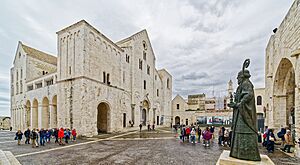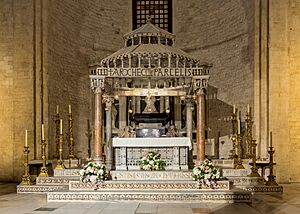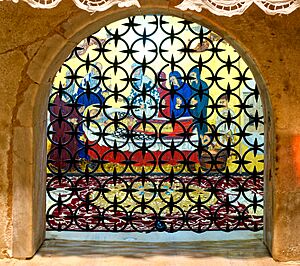Basilica of Saint Nicholas, Bari facts for kids
Quick facts for kids Basilica of Saint NicholasBasilica di San Nicola |
|
|---|---|

Side view with statue of St. Nicholas
|
|
| Religion | |
| Affiliation | Catholic Church |
| Province | Archdiocese of Bari-Bitonto |
| Rite | Roman Rite |
| Ecclesiastical or organizational status | Pontifical minor basilica |
| Year consecrated | 1197 |
| Status | Active |
| Location | |
| Location | Bari, Italy |
| Architecture | |
| Architectural type | Church |
| Architectural style | Romanesque |
| Groundbreaking | 1089 |
| Completed | 1197 |
The Basilica of Saint Nicholas is a very important church located in Bari, a city in southern Italy. This church is special to many people across Europe and the Christian world. It is a popular place for pilgrims, both for Catholics and Orthodox Christians.
Contents
History of the Basilica
Building the Church
The Basilica was built between 1087 and 1197. This was during a time when the Normans ruled the Apulia region of Italy. Bari was an important city in this area.
The church was started because of a special event: some relics (holy remains) of Saint Nicholas were brought to Bari. Saint Nicholas's original shrine was in Myra, which is now part of Turkey.
Moving Saint Nicholas's Relics
When Myra came under the control of the Saracens, some people thought it was a good idea to move the saint's relics to a safer place. A legend says that Saint Nicholas himself, on his way to Rome, had chosen Bari as his burial spot.
There was a big competition between the cities of Venice and Bari to get the relics. Bari won! On May 9, 1087, the relics were safely brought to Bari.
Consecration and Early Leaders
A new church was quickly built to keep Saint Nicholas's remains safe. Pope Urban II was there when the crypt (an underground room) was blessed in 1089.
The entire church was officially blessed in 1197. Many important people, including bishops and nobles, attended the ceremony. Elias, who was the head of a nearby monastery, became the first archbishop of the church. His special bishop's throne, called a cathedra, is still in the church today.
Architecture and Design
Unique Church Appearance
The Basilica of Saint Nicholas looks quite square and strong, almost like a castle. This feeling is made even stronger by the two short, thick towers on the front. In fact, the church was used as a castle several times throughout its history.
Inside the Basilica
Inside, the church has a main area called a nave and two side areas called aisles. These areas are separated by columns made of granite. The area near the altar, called the presbytery, is separated by three arches. These arches are supported by columns that show a Byzantine style.
Above the aisles, there is a special gallery called the matronaeum. This gallery was traditionally for women and opens up into the main nave. The Basilica of Saint Nicholas was the first church to be built with this design. Many other churches in the region later copied its style.
Hidden Water Issues
In 2012, scientists used special tools like ground-penetrating radar and seismic sonar. They found that there was water leaking into two parts of the crypt that were fixed in the 1950s. This might be due to too much moisture building up.
Treasures of the Basilica
Art and Sculptures

The Basilica is home to some amazing Romanesque sculptures from southern Italy. One of the most famous is the cathedra (bishop's throne) that was finished in the late 1000s for Bishop Elias.
You can also see beautiful mosaic floors in the crypt and the presbytery. The ciborium, which is a canopy over the altar, is also decorated with mosaics. It has four columns with designs of leaves, animals, and mythical creatures.
Saint Nicholas's Tomb
The crypt, located underground, has 26 columns with unique tops in both Byzantine and Romanesque styles. This is where the relics of Saint Nicholas are kept.
Other Important Items
Inside the church, there is a 16th-century tomb made of marble for Bona Sforza, who was the Queen of Poland. The museum of the Basilica also has many valuable artworks. This includes a collection of candelabras from the 1100s, given by King Charles I of Anjou.
Restoration Work
The church has been restored several times over the centuries. In the late 1200s, 1456, and the 1600s, work was done to fix and update it. During a restoration in the 1900s, most of the fancy Baroque decorations were removed. Only the gilded wooden ceiling, with paintings by Carlo De Rosa, was kept.
Feast Days and Pilgrimages
Saint Nicholas Day
December 6 is Saint Nicholas Day, which is the main celebration for Saint Nicholas. On this day, the clergy (church leaders) at the Basilica perform a special tradition. They lower a flask into Saint Nicholas's underground tomb to collect some of the myrrh. Myrrh is a special oil that is believed to come from the relics.
Containers of this myrrh are sent all over the world. Many believers have said that miracles happened after they were anointed with it. For some Orthodox Churches that follow the older Julian Calendar, December 6 falls on December 19 of the Gregorian Calendar. So, there are actually two celebrations of this holy day in Bari, both with great ceremony.
Translation of Relics Day
May 9 is another important feast day, especially for the Russian Orthodox Church. It celebrates the "Translation of the Relics of Saint Nicholas from Myra to Bari". This day remembers when the relics were moved to Bari.
Increase in Pilgrims
Since the big changes in Eastern Europe in 1989, more and more pilgrims from that region have visited the Basilica. They come not just for the feast days, but throughout the entire year.
See also
 In Spanish: Basílica de San Nicolás (Bari) para niños
In Spanish: Basílica de San Nicolás (Bari) para niños
- Main sights in Bari
- Cathedral of Acquaviva delle Fonti
- Cathedral of Altamura
- Sanctuary of Monte Sant'Angelo
- St. Nicholas Church, Demre





